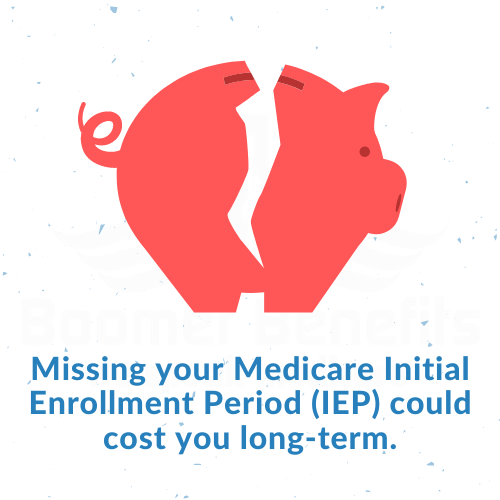Medicare Enrollment Periods
Essential Highlights
Initial Enrollment Period (IEP)
What is the Initial Enrollment Period?
The Initial Enrollment Period, or IEP, is the first opportunity you have to sign up for Medicare. It lasts for seven months, starting three months before the month you turn 65, including your birthday month, and ending three months after.
Why It’s Important to Enroll on Time
Enrolling during your Medicare enrollment period is crucial because it helps you avoid late enrollment penalties. Missing this window can result in higher premiums for Medicare Part B and Part D, and those penalties can stick with you for life.
Personal Anecdote: I once worked with a client named Mary who missed her IEP because she didn’t realize she needed to enroll. She ended up paying higher premiums for years. Don’t let that happen to you!
What You Can Do During IEP
- Sign Up for Medicare Part A and/or Part B: Most people qualify for premium-free Part A, but Part B has a monthly premium.
- Join a Medicare Advantage Plan (Part C): These plans are offered by private companies and provide all Part A and Part B benefits, often with additional coverage.
- Enroll in a Medicare Prescription Drug Plan (Part D): If you need medication coverage, you can sign up for a Part D plan during your Medicare enrollment period.
General Enrollment Period (GEP)
Understanding the General Enrollment Period
If you miss your IEP, the General Enrollment Period (GEP) offers another chance to sign up. It runs from January 1 to March 31 each year, with coverage starting on July 1.
Who Should Use the GEP?
The GEP is for those who didn’t sign up during their IEP and don’t qualify for a Special Enrollment Period. Be aware that enrolling during the General Enrollment Period may result in late enrollment penalties.
What You Can Do During GEP
- Sign Up for Medicare Part A and/or Part B: This is your chance to enroll if you missed the IEP, but be prepared for potential penalties.

Special Enrollment Period (SEP)
What is a Special Enrollment Period?
A Special Enrollment Period (SEP) allows you to sign up for Medicare outside of the IEP and GEP under certain circumstances. These might include losing employer coverage or moving to a new area where different plans are available.
Situations That Qualify for SEP
- Working Past 65: If you have health coverage through your employer or your spouse’s employer, you can delay enrolling in Medicare without penalty. When that coverage ends, you get an SEP.
- Loss of Coverage: If you lose other health coverage, you qualify for an SEP.
- Other Life Events: Moving to a new area, gaining eligibility for Medicaid, or being released from incarceration can all trigger an SEP.
How to Use SEP
To use an SEP, you’ll need to provide documentation proving your eligibility. The process can vary depending on your situation, so it’s essential to have all your paperwork in order.
What You Can Do During SEP
- Enroll in Medicare Part A and/or Part B: Without penalty, if you meet the SEP criteria.
- Join a Medicare Advantage Plan (Part C): If you’re interested in additional benefits.
- Sign Up for a Medicare Prescription Drug Plan (Part D): Ensure you have the medication coverage you need.

Tom, continued working until he was 67. When he finally retired, he used his SEP to enroll in Medicare without any penalties, thanks to the coverage he had through his job.
Annual Enrollment Period (AEP)
What is the Annual Enrollment Period?
The Annual Enrollment Period (AEP) runs from October 15 to December 7 each year. It’s a time for current Medicare beneficiaries to review and make changes to their coverage for the upcoming year.
Why AEP is Crucial
During AEP, you can compare plans and switch to one that better fits your needs. Health needs and plan options can change, so it’s essential to review your coverage annually.
What You Can Do During AEP
- Switch Between Medicare Advantage Plans: Find one that better suits your needs.
- Switch Between Medicare Part D Plans: Ensure you have the best prescription drug coverage.
- Return to Original Medicare: If you’re currently in a Medicare Advantage Plan, you can switch back to Original Medicare.
Medicare Advantage Open Enrollment Period (OEP)
Understanding the Medicare Advantage Open Enrollment Period
The Medicare Advantage Open Enrollment Period (OEP) runs from January 1 to March 31 each year. It’s specifically for those already enrolled in a Medicare Advantage Plan.
Who Should Use OEP?
If you’re already in a Medicare Advantage Plan and want to make changes, OEP is your opportunity. This period allows for adjustments that might better fit your health needs.
What You Can Do During OEP
- Switch to a Different Medicare Advantage Plan: If your current plan isn’t meeting your needs, you can find a better one.
- Drop Medicare Advantage and Return to Original Medicare: If you prefer the flexibility of Original Medicare.
- Join a Medicare Prescription Drug Plan: If you return to Original Medicare, you can add Part D coverage.

Bob used the OEP to switch to a plan with better specialist coverage after he was diagnosed with a chronic condition. It made managing his health much more manageable.
Understanding Medicare enrollment periods can seem daunting, but with the right information, you can navigate it smoothly. Here’s a quick recap:
- Initial Enrollment Period (IEP): Your first chance to sign up, around your 65th birthday.
- General Enrollment Period (GEP): For those who missed the IEP, from January 1 to March 31.
- Special Enrollment Period (SEP): For special circumstances, like losing employer coverage.
- Annual Enrollment Period (AEP): Review and change plans from October 15 to December 7.
- Medicare Advantage Open Enrollment Period (OEP): For those in Medicare Advantage, from January 1 to March 31.
Remember, marking these dates on your calendar and seeking help from a Medicare advisor can make the process much easier. If you have any questions or need personalized assistance, don’t hesitate to reach out. Your health coverage is crucial, and understanding your options will help you make the best decisions for your future.